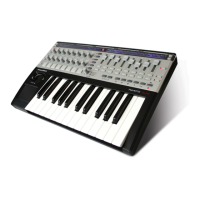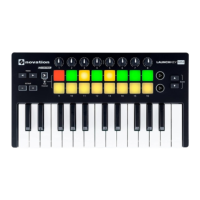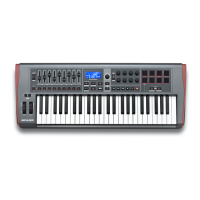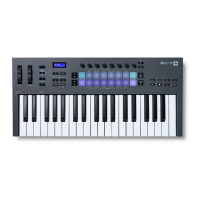33
RE3: Chorus 1 Speed
Displayed as: Ch1Rate
Initial value: 20
Range of adjustment: 0 to 127
The Rate parameter controls the frequency of the Chorus processor’s dedicated LFO.
Lower values give a lower frequency, and hence a sound whose characteristic changes
more gradually. A slow rate is generally more effective.
RE4: Chorus 1 Sync
Displayed as: Ch1Sync
Initial value: Off
Range of adjustment: See table at page 40
Chorus Rate may synchronised to the internal or external MIDI clock, using a wide variety
of tempos.
RE5: Chorus 1 Feedback
Displayed as: Ch1Fbck
Initial value: +10
Range of adjustment: -64 to +63
The Chorus processor has its own feedback path between output and input, and a certain
amount of feedback will usually need to be applied to get an effective sound. Higher values
will generally be needed when Phaser mode is selected. Negative values of Feedback
mean that the signal being fed back is phase-reversed.
RE6: Chorus 1 Depth
Displayed as: Ch1Depth
Initial value: 64
Range of adjustment: 0 to 127
The Depth parameter determines the amount of LFO modulation applied to the Chorus
delay time, and thus the overall depth of the effect. A value of zero produces no effect.
RE7: Chorus 1 Delay
Displayed as: Ch1Delay
Initial value: 64
Range of adjustment: 0 to 127
Chorus Delay is the actual delay that is used to generate the chorus/phaser effect. Dynami-
cally altering this parameter will produce some interesting effects, though the difference in
sound between different static settings is not marked, unless Chorus Feedback is at a high
value. The overall effect of Chorus Delay is more pronounced in Phaser mode.
Modulating Chorus Delay with an LFO gives a much richer, dual chorus effect.
RE8: Not used.
Gator Menu
The built-in Gator is a very powerful Novation effect. In essence, it is similar to a Noise
Gate, triggered by a repeating pattern derived from the internal or external MIDI clock. This
breaks a note up rhythmically. However, as well as being able to control the more “tradi-
tional” sonic aspects of a Noise Gate, you can also edit the patterns, to create a sequence
up to 32 notes long, each note having its own volume, if desired. The pattern is saved
with any other changes you make to the Patch, so you can think of the Gator as a 32-step
volume sequencer.
Note that for the Gator to have its full effect, the FX Amount setting for the Slot
into which it is loaded needs to be at maximum - 127. In addition to this, the FX
Routing configuration will also have a bearing on its audibility.
The UltraNova has one Gator. It can be loaded into any of the FX slots. Unlike the other FX
Menus, the Gator Menu has two pages.
Gator Menu Page 1 – gate parameters
RE1: Not used.
RE2: Gator On/Off
Displayed as: GtOn/Off
Initial value: Off
Range of adjustment: Off or On
This switches the Gator effect on or off.
RE3: Gator Latch
Displayed as: GtLatch
Initial value: Off
Range of adjustment: Off or On
With the Latch Off, a note sounds only while its key is pressed. With Latch On, pressing
a key will cause the note, modified by its Gator pattern, to sound continuously. It is can-
celled by setting GtLatch to Off again.
RE4: Gator Rate Sync
Displayed as: GtRSync
Initial value: 16th
Range of adjustment: See table at page 40
The clock driving the Gator’s trigger is derived from the UltraNova’s master tempo clock
and the BPM may be adjusted by RE8 in the Arpeggiator Menu. Gator Rate may synchro-
nised to the internal or external MIDI clock, using a wide variety of tempos.
RE5: Gator Key Sync
Displayed as: GtKSync
Initial value: On
Range of adjustment: Off or On
When Key Sync is On, every time you press a key, the Gator pattern restarts at its begin-
ning. With Key Sync Off, the pattern continues independently in the background.
RE6: Gator Edge Slew
Displayed as: GtSlew
Initial value: 16
Range of adjustment: 0 to 127
Edge Slew controls the rise time of the triggering clock. This in turn controls how fast the
gate opens and closes and thus whether the note has a sharp attack or a slight ‘fade-in”
and “fade-out”. Higher values of GtSlew lengthen the rise time, and thus slow down the
gate response.
RE7: Gator Hold
Displayed as: GtHold
Initial value: 64
Range of adjustment: 0 to 127
The Gator Hold parameter controls how long the Noise Gate is open for once it has been
triggered, and thus the duration of the note heard. Note that this parameter is independent
of the clock tempo or Rate Sync parameter, and that the note duration set by GtDecay is
constant, whatever speed the pattern is running at.
RE8: Gator Left-Right Delay
Displayed as: GtL/RDels
Initial value: 0
Range of adjustment: -64 to +63
To enhance the effect of sequenced patterns further, the Gator includes a dedicated delay
processor. When set to zero, the notes in the pattern are centrally located in the stereo
image. With positive values, the notes are panned hard left and a delayed repetition of the
note is panned hard right. The value of the parameter controls the delay time. With negative
values, a pre-echo results (an echo which precedes the note). The stereo imaging is the
same, with the timed pattern note itself on the left and the pre-echo on the right.
Gator Menu Page 2 – pattern editor
The pattern is depicted by the solid white characters to the right of the display, each of
which represents the level for that step. There are two rows of 16 characters (see table
page 44) as {A} and {B} respectively. Each row’s 16 notes are further divided into 4 Edit
Groups, giving a total of 8 Groups. The height of the character represents the volume of
the note within the sequence, which is also adjustable. See RE5-8 for more information.
Note that in this menu page, the rotary encoders do not line up exactly above the
areas of the LCD display they relate to.
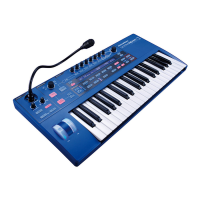
